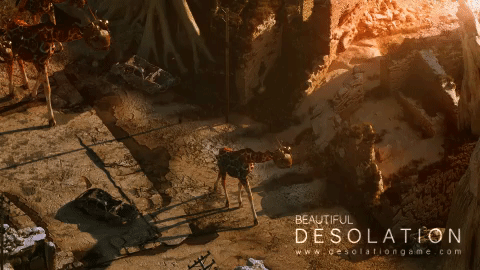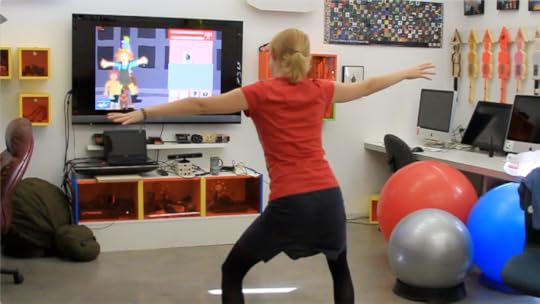Kill Screen Magazine's Blog, page 61
September 7, 2016
Artist imagines what Instagram would look like on Windows 95
Windows 95 had a lot going for it: its iconic startup sound; its soothing teal background; Internet Explorer in its earliest, purest form; and my personal favorite, the Paint program. Today, if you’re ever feeling particularly nostalgic, you can run Windows 95 in your browser. (True to history, attempting to use Internet Explorer will cause the emulator to crash.)
But the emulator reveals a conspicuous absence: no Instagram. Yes, Instagram only launched in 2010, and as a free mobile app rather than a Windows 95-friendly .exe program. But what if it had come into existence two decades earlier? Russian graphic designer Misha Petrick answers this burning question for all of us with Instagram for Win95.
In all of its retro, pixelated glory
Petrick’s project explores what the app would have looked like with the 90s aesthetic that its present-day users strive for on a daily basis. His series of animations showcases what the interface would have looked like way back when, in all of its retro, pixelated glory. Painstakingly choosing a filter for your ’gram is complicated enough today, but Petrick adds another layer with 90s-themed filters such as “Apple II,” “Mac ’86,” and “1-bit.”
Petrick also animated how it might have looked to scroll through a user’s feed and to receive notifications on new likes, comments, and followers. Limited by its ancient operating system, Instagram for Win95 is chunkier and clunkier than the real thing, but there is a beauty in that. Looking at the two side by side, it is hard not to appreciate how far we have come in the past 20 years.
Go back in time and check out ye olde Instagram here .



The post Artist imagines what Instagram would look like on Windows 95 appeared first on Kill Screen.
Epipen Tycoon is angry and wasteful, much like the company it seeks to skewer
Wouldn’t it have been easier to tell Mylan CEO Heather Bresch—whose main claim to fame involves jacking up the price of Epipens in the US—to delete her account? Is The GOP Arcade’s latest release, Epipen Tycoon, a game with which we must reckon simply because Bresch does not currently have a Twitter account to be memed into submission? What a waste.
Fair warning: I’m going to spoil the end to Epipen Tycoon in this paragraph because there’s so little to the game that it cannot be discussed otherwise. You play as Bresch. “Your shareholders want results,” the game informs you. “Your customers want not to die of anaphylactic shock.” You have the power to alter the price of Epipens, angering either customers or shareholders. Equilibrium can’t really be achieved here. You can raise prices more slowly or make drastic cuts when people get annoyed, but in the end someone will get angry and you’ll lose the job. People will die or the board will freak out. You’ll get ousted. The end.
little more than world-weary cynicism masquerading as political insight
And then what? The game’s over, that’s what. Epipen Tycoon amounts to a giant rhetorical shrug. The system will keep going whatever you do, a point that could count as scabrous critique in more deft hands. But, here, condescending ire is also reserved for the Twitter horde that bullies Bresch out of her job after price hikes. “You set the prices too high and couldn’t handle the nonstop Twitter abuse and constant thought pieces about how evil you are on Medium,” the game announces. “It’s time for you to resign and probably take another CEO job at a different drug company.”
As with The GOP Arcade’s previous release, Thoughts and Prayers, a certain amount of this derision for hashtag activism is fair, but its fatalism ultimately comes across as derision against well-meaning people. In the absence of an alternate model for social change, this sort of posturing comes off as little more than world-weary cynicism masquerading as political insight. The GOP Arcade is that guy in your intro Poli Sci course.
In its desire to rain disdain on everyone in sight, Epipen Tycoon somehow manages to let most of the offending parties in l’affaire Mylan off the hook. The surge in Epipen prices is a peculiarly American story. The change in prices is not immediately borne by the consumer. Mylan has taken to handing out coupons as a form of damage control, which means the added cost is not coming straight out of the pockets of concerned parents. Rather, Epipen hikes are a way of bilking insurers, the effects of which are then indirectly passed back to parents who worry about their kids’ allergies as part of their premiums. This is a game plenty of drug makers play, but Mylan played it badly, delaying its various rebate efforts and otherwise being clumsy. (Come to think of it, that is a more compelling game than Epipen Tycoon, but I can only review what is in front of me.)
The precise nature of the system that makes this whole sorry mess possible is entirely missing from the game, which is both strangely exculpatory and a way of making Heather Bresch look like just another cog. If the implicit logic of Epipen Tycoon is that none of this would happen under single-payer healthcare, the argument is only apparent if you had already come to that conclusion, in which case the game serves no persuasive purpose.
What bothers me about Epipen Tycoon, and The GOP Arcade’s output in general, is that there are brief moments of promise in all of these games. It’s true that people who tweet about thoughts and prayers aren’t going to change laws just as it’s true that CEOs have incentives to raise drug prices, but the developers don’t seem to know what to do with these pieces of intuition. Instead of using game mechanics to illuminate how structures work or build a compelling critique that would not work in another medium, play is being used as a delivery mechanism for smarm. Epipen Tycoon’s resemblance to a game is purely aesthetic—a justification for the “tycoon” in its name. What a waste.
You can play Epipen Tycoon in your browser.
The post Epipen Tycoon is angry and wasteful, much like the company it seeks to skewer appeared first on Kill Screen.
Moon Hunters is about legends, but isn’t quite legendary
Our ancestors courageously spoke their minds, fought against tyranny, ended wars, and along the way also probably made a lot of really stupid mistakes. Just because we don’t care as much about our time-honored heroes’ failures doesn’t mean they didn’t happen, it just proves that history has a way of selective forgetfulness.
The truth? Our legends aren’t always necessarily as legendary as we’d have liked them to have been. Johnny Appleseed’s countless apple trees bore mostly inedible fruit, designed to produce lucrative cider, rather than out of an altruistic goal to feed the masses. Paul Revere may have ridden to alert his fellow revolutionaries of the coming British soldiers, but his role in the ordeal was minimal at best; his ride wasn’t even mentioned in his own obituary.
like most board games, it remains entertaining when pulled out periodically
In the same way, Moon Hunters makes it easy to forget the moments when you cheesed your way through waves of monsters with the same overpowered moves, instead hailing your strongest moments of decisiveness as legends for the ages.
A co-op, roguelike RPG at its core, Moon Hunters lets up to four players choose from six different heroes of varying backgrounds and strengths—a wandering swordsman from the mountains, a dark mage adorned in skulls, or a silver-haired songstress, for example—and set out on their journey. In its fantasy world of Issaria, the moon has vanished, and the vicious Sun Cult has threatened to kill all nonbelievers in five days. Our heroes must find a way to bring the moon back, and the game is upfront with the fact that you will most likely not succeed. Depending upon choices made throughout the game, as well as the outcome of the final battle, our warriors’ fateful days can come to a variety of endings
Rather than hew to typical roguelike punishment for death—resetting the entire game from scratch upon restarting—Moon Hunters elevates itself beyond similar randomly-generated titles by making your choices live on in the folklore of the world of Issaria. After those five days have passed, each player is rewarded with a constellation and legend describing who each character was in the hearts and minds of their fellow villagers.
Astrologically speaking, the generated legends and constellations spun from each playthrough are about as accurate as your typical horoscope—sure, there are some similarities in what’s on the page to what actually happened if you squint at it. Regardless, it imbues each playthrough with the feeling that you can play whatever role you choose—will you be a selfless warrior defending the righteous, a vengeful sexpot looking to destroy your enemies, or a mix between the two? Interactions with NPCs are often binary choices, but thankfully they don’t fall into the typical black or white dichotomy so prevalent in videogame morality choices. Which of these two princes is more handsome? Should the villager kill or tame the evil-looking bird? Depending on your answer, your character may be branded patient, proud, vengeful, or cunning, or something else entirely.
Moon Hunters may not be the perfect game, it nobly aims for the stars
Each playthrough proceeds like the rounds of a board game, with players choosing areas on the randomly-generated map to visit each day, and then picking a different skill-boosting job at camp each night. Consecutive playthroughs unlock more heroes and more types of level geography, from forests to mountain tops to deserts. Moon Hunters strives to be a bite-sized epic and in that it succeeds. One entire journey typically takes around 30 minutes, encouraging players to try again, tell another tale, and create a new myth. That said, like most board games, it remains entertaining when pulled out periodically. Plowing through the game to unlock every hero, costume, and other options would quickly grow tiresome.
While it’s possible to go it alone, Moon Hunters shines with a full group (the PS4 version supports local co-op, while PC players can connect online). Arcade-style controls ensure it remains approachable for players who aren’t even sure what the acronym “RPG” stands for, so gathering together your band of heroes should be relatively easy. Varying combinations of characters leads to different experiences, with some warriors more suited to long-range attacks or support, and others need to get in close. The combat itself is a lightweight, button-mashing affair, with a few overpowered characters able to make relatively short work of the challenges thrown at them. However, group playthroughs make decisions somewhat arbitrary, as choices that affect the group boil down essentially to coin tosses. For a title so dependent on group play, the resulting legends are singularly focused and seem to ignore the group dynamic. Romulus and Remus both created Rome, and Orion hunts the Ursa Major through the night sky, yet our heroes tales are spun with only their sole actions in mind.
Legends, as we think of them, are often times passed down in misconstrued, exaggerated forms, taking sometimes everyday occurrences and elevating them to mythical proportions. Lady Godiva never actually rode her horse nude through a town, nobody seems sure whether King Arthur or Robin Hood really existed, and not only did William Tell never shoot an apple off of his son’s head, there’s a whole list of marksmen who supposedly did it. But does that matter? We look to our legends for inspiration and hope, not for historical fact. Just the same, while Moon Hunters may not be the perfect game, it nobly aims for the stars, and for that alone it is memorable.
For more about Kill Screen’s ratings system and review policy, click here.
The post Moon Hunters is about legends, but isn’t quite legendary appeared first on Kill Screen.
September 6, 2016
Stare wildly at the mutated giraffes of a game set in far-future Africa
“Set in a distant future in an evocative African landscape … he is not from this place or time …” states the tantalizing blurb on Beautiful Desolation‘s website. Those are the only hints regarding the narrative of the next adventure game from The Brotherhood, the team behind bleak sci-fi horror adventure Stasis (2015) and its upcoming side story Cayne. Implications of dimensional and time travel aside, it’s the isometric landscape of distant future Africa that intrigues the most. It’s a world years in the making, first conceived before and then developed during the creation of Stasis.
heads bulging with lumps of flesh and massive horns
“Several years ago we had an idea for an adventure story set in a post-apocalyptic world. During our brain storming sessions, we kept circling back to a particular story. It was pushed to the sidelines while the STASIS story blossomed,” states the game’s creator Chris Bischoff in a recent update on NeoGAF. “But now that we want to do something different outside the STASIS universe, and still create an experience that fits into our niche of point-and-click, isomeric adventure games.”
Those years of world-building and the desire to continue evolving the isometric adventure have coalesced to form Beautiful Desolation, created through scanned miniatures, 3D models, and 2D paintings. Few details are available at the moment, but the reveal footage offers a peek into a place that has survived ruin, of life thriving among the remnants of civilization.
A herd of mutated giraffes walk past the rusting remains of vehicles and power lines, their long necks topped by heads bulging with lumps of flesh and massive horns. An indistinct creature swims alongside a cliffside waterfall and long-abandoned warship. Even the one interior we see isn’t devoid of signs of life, a holographic display contrasting with the rustic lodge atmosphere of hide rugs and mounted skulls. Clearly people—or at least intelligent beings— still exist in this far-future land.
Beautiful Desolation is very early in development, but is expected to release on PC at the very least. A crowdfunding campaign is slated for sometime this year. To follow the game’s development, follow The Brotherhood on their site and Twitter page.



The post Stare wildly at the mutated giraffes of a game set in far-future Africa appeared first on Kill Screen.
ReCore downplays its robot dog, which is all we care about
When ReCore’s first trailer premiered at E3 2015, the protagonist Joule and her scrappy robot dog charmed everyone with their expeditious tag-team adventure. Evoking Rey’s lone scavenger vibe from Star Wars: The Force Awakens (2015), the brief blast of combat at the trailer’s end promised creative, cooperative action—and a canine companion with the trick of interchangeable bodies, so you never need worry about the dog dying. Joule and co. seemed sweet, despite their attacking prowess, and the idea of an open desert to romp through and explore was tantalizing.
weird, hidden garages full of violence
Pre-release material has since hinted at a marginally different tone for the full game. The Gamescom trailer looked like it was taking Joule to new adventures via those Star Wars droid factories, but despite their grandness, they didn’t feel out of place in the middle of a desert. The very first ReCore teaser showed hollow metal scraps scattered across the wastes and filled with dangerous things: it makes sense that later material would explore this further.
The launch trailer, admittedly, does do that. It centers these weird, hidden garages full of violence to such an extent that, to someone who had just watched the earlier trailers, it would be almost unrecognizable as the same game. Joule’s sweet robot pets are featured primarily as vehicles and weapons. She darts among gunshots and lasers and aimless explosions, a tiny slingshotting thing drowned out by the startling voice of the trailer’s narrator, who attempts to explain the situation Joule finds herself in, and says he is her father.
And so it is revealed that ReCore has a plot. It checks off the trope-laden boxes of missing family member; vague yet ominous tragedy; a man with a deep voice about whom you are pressured to care. There’s barely enough information to tell what the story is, much less how well executed it would be, but it’s permanently changed ReCore from “a game about a girl and her robots” into “a game about a girl and her robots, and constant combat, and her dad.” Time will tell if the second option can match the charm and allure of the first.
ReCore comes out for PC and Xbox One on September 13th. Find out more on its website.
The post ReCore downplays its robot dog, which is all we care about appeared first on Kill Screen.
Want more Firewatch? It’s getting two new game modes soon
Campo Santo has been sorta laying low since the release of Firewatch earlier this year. But that time is over. The studio has now decided it’s about time to deliver DLC for the game in the form of two new and much-requested modes. The announcement came alongside the Xbox One version’s reveal, which arrives on September 21st.
The two new modes are an Audio Tour, which is a mix of scavenger hunt missions and development diaries. It’s going to be implemented in the game’s main storyline from the beginning by giving the protagonist, Henry, a Walkman and headphones before he heads out into the wilderness. At that point, you’ll be challenged to find more than 100 tape cassette kiosks spread across the woodlands.
indulge the wonderful nature and wildlife within
Each in-game day will offer a new set of tapes to collect with various themes, ranging from the difficulties the development team had to overcome, their own choices while playing Firewatch, and a simple commentary on the situation you find yourself in. “Each tape tells you what you’re going to learn about, and your map has a checklist of all the tapes that exist in the world on that day of the game,” said studio director Jake Rodkin to Rock, Paper, Shotgun. Sometimes the tapes will offer more than mere sound clips too, letting you see a glimpse of how the team over at Campo Santo made the game and the way they animated Henry.
The other new mode that’ll come with this expansion is a free-roam mode. As you’d expect, it’ll offer the chance to walk the game’s environments as you wish, and indulge the wonderful nature and wildlife within. Free Roam removes the story completely from the game and gives you access to all the tools from the beginning to set out on your own sightseeing adventures, turning the game into more of a hiking simulator. Rodkin discussed the reason behind adding this new mode by saying that the team is trying to cater to the “type of person who really likes the world of Firewatch and the “virtual hiking”/sightseeing/tourism aspect of exploring it, and wanted to be able to live in it for a little while, poke around at their own pace without having to feel the pressure of the story.”
The Firewatch Audio Tour mode will be available upon release for Xbox One players on September 21st, with PS4 and PC players having to wait a little while longer. The game’s Free Roam mode doesn’t yet have a set release date.
The post Want more Firewatch? It’s getting two new game modes soon appeared first on Kill Screen.
The Oxenfree alternate reality game you probably didn’t know about
It all began with a phone number hidden within Oxenfree’s in-game radio stations, or “anomalies.” When called, it played the song “Beacon Beach,” by artist scntfc, the composer behind the game’s soundtrack.
Well, so what?
Go back and listen again and you’ll find lines of morse code in the song, with messages such as “Maggie,” “All is lost,” and most interestingly, “Search Twitter 4 num.” Internet sleuths looking the number up on Twitter found a cryptic profile, and so began Oxenfree’s alternate reality game (ARG) set out by the creators of the supernatural teen drama at Night School Studio.
the discovery of a one-of-a-kind music box
To explain what happened after that, Damien Bamford recently released a short documentary about the ARG, profiling its discovery and its participants’ journey through the Pacific Northwest. Following the group of around 20, Bamford’s documentary shows the strange journey Night School Studio and scntfc sent its fans on, culminating in the discovery of a one-of-a-kind music box created by the composer at Washington’s Fort Ward.
Speaking to Bamford, scntfc explains he and Night School would release cryptic codes for players to investigate and solve, revealing slowly but surely more pieces of the puzzle until ultimately they revealed a date and location for a real-world chapter of the game. Scntfc was actually the one who physically went out and set the game up, building rock formations similar to those seen in the game, hiding clues and cassette tapes, and making sure players were led to their goal.
The documentary is worth a watch to see the back-and-forth the creators and players had, the all-seeing-eye Night School used to watch every step of its game, and the organization of a pretty large community to come together and discover its secrets. Its also an endearing look at the bonds and friendships made through investigation and discovery, very similar to theme of the game itself.
For more on Oxenfree, read our review. You can also follow Bamford on Twitter to keep up with his future projects.
The post The Oxenfree alternate reality game you probably didn’t know about appeared first on Kill Screen.
Please give a round of apaws for David Kanaga’s dog opera videogame
Have you ever been to the dog opera before? Well, you simply must go! If you haven’t, David Kanaga has you covered. Co-creator of Proteus (2013) and Panoramical (2015), Kanaga will be showing off the Oik OS Book during the Fantastic Arcade from September 26-29th in Austin TX. According to the information provided by the Fantastic Arcade website, Kanaga’s game “is a dog opera computer game for Mac OS and Windows. It is the first book of a planned series about getting the household in order.”
an interesting display of four-legged friends
The Fantastic Arcade curates a selection of independent games from upcoming game makers and designers that offer something different and interesting. The event treats games as a medium akin to independent films—so an interactive dog opera won’t be barking up the wrong tree. But what exactly is a dog opera? Kanaga’s website for the project offers a few glimpses: upon entering the site, a wave of sporadic-sounding notes flood the room. Illustrations of dogs and a slow moving GIF featuring what I can only assume is screenshots from the opera are featured as well.
If the cryptic website above is a little too confusing, there’s a video on the Fantastic Arcade website. It’s a serene, minute-long video with a goat and a rabbit perched on the edge of a cliff, enjoying the sunset and gazing across a body of water. The background music is silly but fits the tone. There is a lack of good boys in this preview but one thing is for sure: the Oik OS Book will be an interesting display of four-legged friends.
For more information on David Kanaga’s project, click here .

The post Please give a round of apaws for David Kanaga’s dog opera videogame appeared first on Kill Screen.
An Xbox game about the difficult performance of being a woman comes out soon
Gender norms are a pain. For women, it means that every day there’s a pressure to conform to certain standards of living that don’t always match up with our personalities. We’re told to straighten our hair. Use makeup. Wear long dresses. Don’t become videogame journalists. These are just a few of the ways society has talked down to me personally, telling me what to do and how to live my life. Dealing with that pressure to conform is awful, and it can cause major stress down the road.
Perfect Woman is a tongue-in-cheek game about the ways in which women are pushed to perform different roles in their lifetime. Developed by Peter Lu and Lea Schönfelder, the game takes place over the course of a woman’s life: going through every stage from the womb to old age. Using motion-sensing technology (i.e. a camera), the game asks players to use their entire bodies to make decisions about their female avatar’s behavior. At each life stage, a bunch of possible paths are possible for them to take, and once one is chosen, players then act out onscreen poses to “perform” that role as well as possible. The better the match, the more perfect the woman has performed her gender role for society.
there’s no such thing as being the ideal woman
Kill Screen previously covered Perfect Woman back in 2013. But now the game is looking at an Xbox One release on September 14th. Relying on the Kinect for its physical performances, decisions and successes (or lack thereof) early on in life impact where the player’s avatar ends up later on. Taking care of a young sibling during wartime years may make your perfect woman a natural mother, but too much alcohol at a young age could lead to challenges holding down a career in her 30s.
It’s not easy being perfect, and the game suggests that there’s no such thing as being the ideal woman. Everyone has their flaws and problems, and no single woman can fulfill all of the roles and behaviors that society says women should possess. Perfect Woman is more than happy to poke fun at the idea, satirizing everything from motherhood to international politics. And the full-body performance of the player strikes at the physical toll of such expectations on a woman’s body.
To find out more about Perfect Woman in action you can visit the game’s website. There’s also a commentated playthrough available from 2015 on Vimeo, exploring the mechanics behind the game.
The post An Xbox game about the difficult performance of being a woman comes out soon appeared first on Kill Screen.
In defence of Bethesda’s notorious videogame glitches
Glitches and bugs have become the hallmark of Bethesda Softworks’ renowned 3D RPGs. Their releases are riddled with them: Fallout 3 (2008) regularly sent robots and Deathclaws flying through the air, The Elder Scrolls IV: Oblivion (2006) had an arrow duplication glitch that led to the greatest YouTube videos in the world, and characters fell through the map in The Elder Scrolls V: Skyrim (2011), like, all the time. Any upcoming Bethesda game is met with excitement, and then a caveat: you’ll have a great time… if you can make it through without glitching. Some are little, like characters clipping through walls or creatures getting stuck and stretching in hilarious ways, but others are much more annoying: the Unofficial Elder Scrolls Pages’ wiki is riddled with footnotes about quest order, lest you lock yourself out of something important because an NPC accidentally set the wrong stage. Game-breaking bugs are common, and all of them crash, a lot.
Despite all of this, many players quickly found out that some glitches were consistent and reliable—reliable enough to be used as you would any other mechanic in the game. They’re overwhelmingly written off as cheats, used to trick the game into a lesser experience, but they also provide an interesting contradiction: an experience delivered in whole, but functionally different from what was intended by its designers. The exploitation of glitches creates the mimicry of a proper world, laid over what their writers and artists desired to create, looking very similar but not the same. The interactivity of the medium ensures that this is a phenomenon specific to videogames, and that every time the player encounters one, they are presented with a choice: do I take advantage of this?
a mimicry of a proper world, looking very similar but not the same
I was in middle school when I first played The Elder Scrolls III: Morrowind (2002). Videogames were, at that impressionable age, huge worlds rich for exploration and wonder, locked behind technology I had yet to reach or own. I’d spend hours watching my older cousins play, the screen a source of never-ending wonder. My earliest memory of Morrowind was of a cousin patiently walking me through the character-creation process, giving me insight on the best class build and star sign to choose, and then saying, “Okay, now pick up that halberd on the wall, trap that guy behind the desk and kill him to get his armor.” A curious way to begin an RPG, though I didn’t know it at the time. I dutifully accepted the character’s fetch quest—before Bethesda introduced essential characters, killing quest-givers like this guy too early would break the game—and stuck a polearm in him. From then on, every new character I made in Morrowind was accompanied by a full set of Imperial Templar armor.
These shortcuts piled up. Drop all your gold to clear your bounty for free. Push an NPC into a corner so you can steal all their stuff. Use a lockpick until it’s almost broken, sell it, buy it back for dirt cheap but with all the uses refreshed. There was even a moving while over-encumbered glitch, one that took Bethesda another two games to realize it should be a legitimate mechanic. Some were passed down to me from cousins and cousin’s brothers and cousin’s brother’s friends, while others were discovered through trial and error: it was the kind of game where, if you pushed at the seams often enough, something would give. It was a world of possibility, to explore the story that was written, and to exploit the glitches that were given to me.
My unfortunate victim. Sorry, dude.
I never found it important that the game wasn’t intended to be played this way. Back then, games didn’t have creators—they were independent worlds that loaded into existence as I arrived in them. I was away from any notion of “purity,” of “author’s intent,” so it was impossible for me to care about taking their route. And, also, why should I? It was pretty obvious that you weren’t supposed to get high-level armor five minutes after the introduction because of bad AI pathing, but hey, it’s in the game, so it’s not against the rules.
I learned later that PC users were able to use console commands to break the game just as thoroughly: tcl to wander around the map at their will, killall to wipe out entire areas, coc testinghall to access, well, everything. It’s not that I didn’t understand the appeal. Someone who wants to walk around in full Daedric armor at level one is committing the same sin against authorial intent that I did every time I killed Sellus Gravius. The difference was that I believed what I still do, to some extent. And that is, if the rules—the software, the world given to you—let you do it, then you can. These commands were exploiting the game from outside; while using glitches, what I was doing, was utilizing what was presented within.
if the world given to you lets you do it, then you can
The internet and the wider gaming community often disagreed. They may have come to terms with Bethesda’s bugs long ago but debates still remain: Have you really beaten a game if you exploited a glitch? If you “cheated” within parameters that are accessible inside the game? What about outside, as applies to console commands? How grievous is each level of sin, and how by-the-book do you have to be to bypass that? There are essays upon essays dedicated to what should be allowed in speedrunning and other forms of competitive play, where strict rules are key to a level playing field. A pre-teen alone with Morrowind is different. It didn’t matter if I was playing the game right, because I was playing the game.
In this curious space between the game intended and the game delivered lies the true treasure of Bethesda’s bug-ridden masterworks: an illustration of a story that cracks at the whim of the code, the texture, or the player, revealing the warping mesh beneath. Approached traditionally, this is a flaw to be ignored or covered up. Approached organically, it is just another aspect of an interactive medium, there to be utilized (or exploited) at will.
This is a Dragon Break, right? This is probably a Dragon Break. (via maniac-online)
The conditions presented by working outside or against the systems aren’t always harmonious. Such is the nature of the glitch. This came up recently during a family board game. Near the end of the game, one participant forfeited to me his hand, and along with it control of his house and holdings. Another player did the same to my cousin. We played as before, using the ceded houses’ cards in battle but not moving their pieces due to laziness, but by mutual consent. I then won the game through a move I thought to be very clever and my opponents very treacherous, attacking my wedded house for the land gains that I needed, fully aware that I could play whatever card I liked in order for them to lose.
The other players argued against this, understandably. In their minds, what I had done was no different than if I had looked at my opponent’s hand and put down a card of my choice, extrajudicially and unfairly. Since my tactic was unaddressed in the rulebook, it was forbidden. I contested that. After all, I was given the ability to play the hand outside of the rulebook, too. I played the hand. Why couldn’t I do it?
Like glitches in a videogame, our acceptance of other’s cards created a secondary world beyond the intent of the authors and designers: one where the rules could be followed to the letter, but also one with circumstances that came with no rules. For many, the presence of this gap is a mistake to be remedied. It surely intrudes on the intent of the authors and the strict conditions necessary to make a game work as it should. But its presence in videogames at all should be enough to give people pause.
glitches are as much a function of their world as any other
Why only approach games with this rigidity? Unlike my unfortunate board gaming experience, no one is watching you flaunt authorial intent. A game is sold to you with taglines and a summary, with a trail that you are intended to follow—some easily seen, some buried so deep as to be invisible—but the product given to you is untrue to that just by nature of being a game. Instead of being a wall of words presented to us for $19.99 at Barnes and Noble, games are a reactive environment that gains meaning and power through interaction. Glitches are as much a function of their world as any other. What separates them from mechanic is intent.
And games would be nothing without intent. Absent of the ability to guide the player through the world in some semblance of order, stories in games would be unintelligible, and the player lost. But they also cede power to the player, giving them the choice, as in Bethesda’s RPGs, to follow the path given or wander without direction and create their own. The choice to use glitches—to use the world presented to you, not the one originally designed—is a choice all the same. And for Bethesda, as we know, choice is everything.
The post In defence of Bethesda’s notorious videogame glitches appeared first on Kill Screen.
Kill Screen Magazine's Blog
- Kill Screen Magazine's profile
- 4 followers














